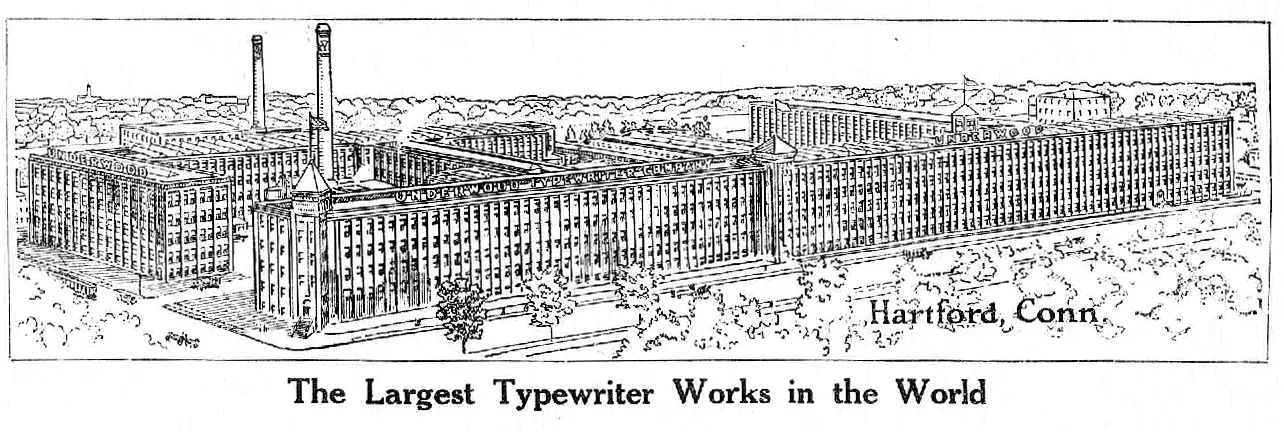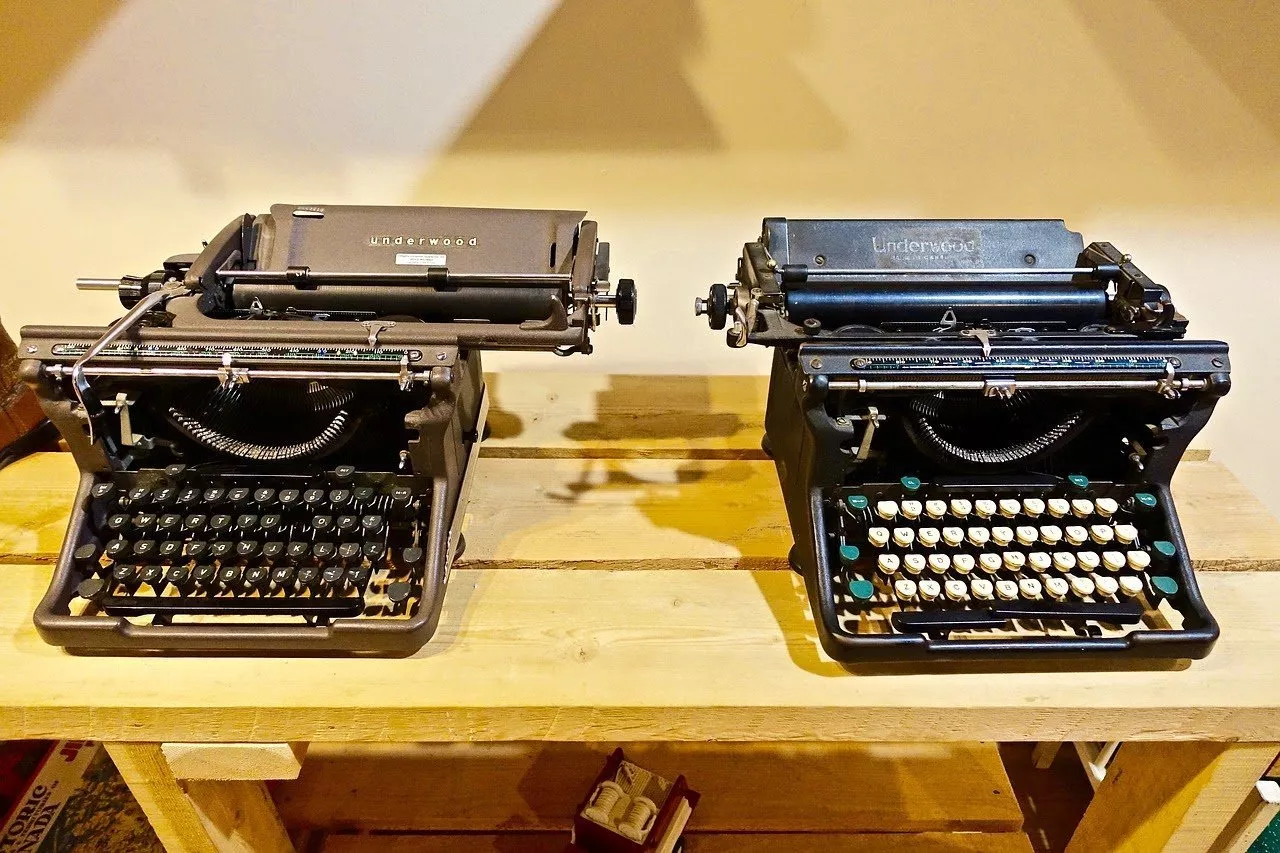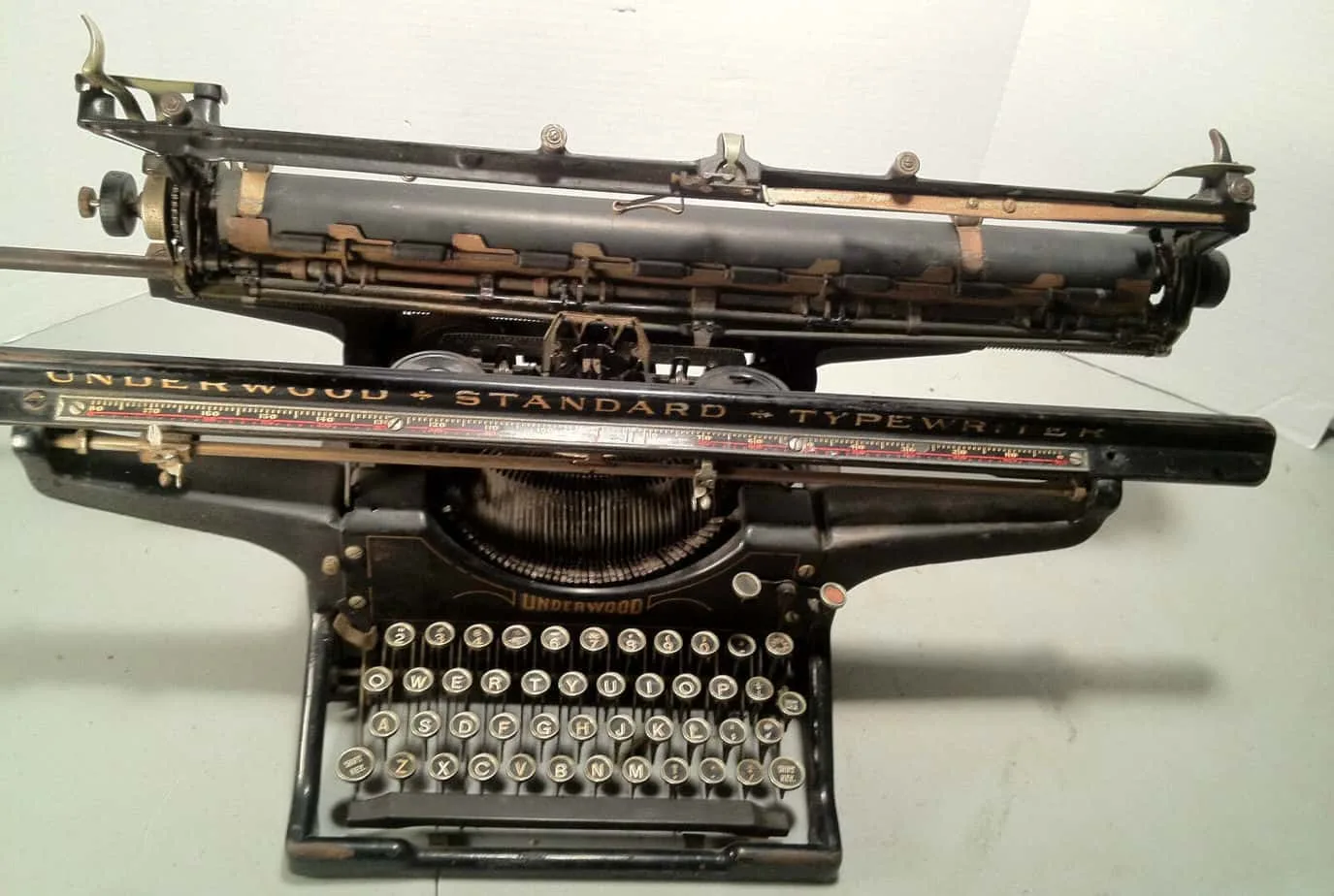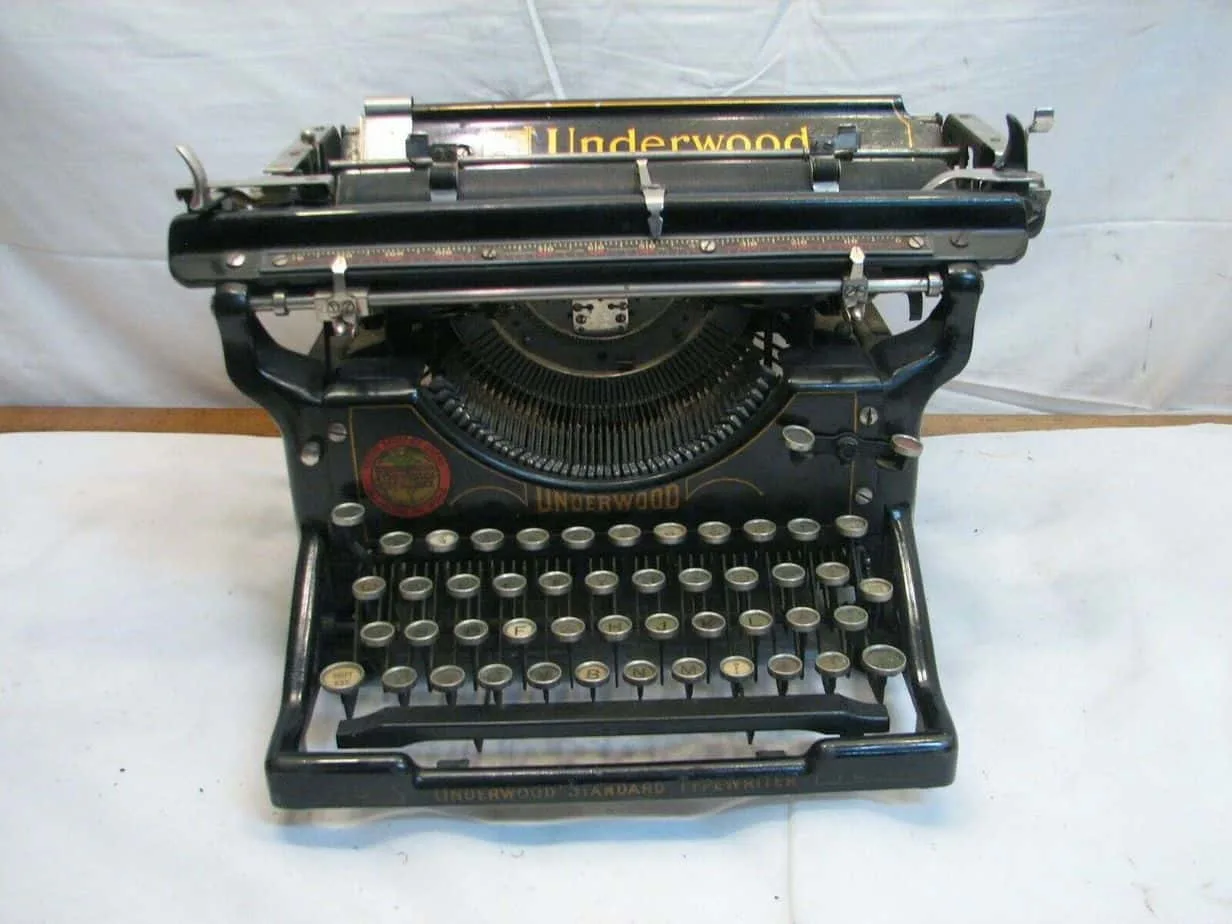- Vintage Samsonite Luggage Guide - February 5, 2022
- Looking Back at the Wooton Desk: A Unique Collectible - December 27, 2021
- Antique Spotlight: The Hoosier Cabinet (Ultimate Kitchen Decor) - December 27, 2021
Typewriters aren’t used much anymore, but they haven’t lost their luster. They’re intriguing machines that are excellent vintage accents in your home.
Underwood was one of the most well-known manufacturers of typewriters in the 20th century, and you may be surprised to find out that there were millions produced and they were so well built that they’re very easy to find and most of them still work.
If you’re in the market for a vintage typewriter, one of the popular Underwood type writer models will likely be the easiest for you to find and the best option, whether you’re going to use it or put it on display for everyone to see.
History of the Typewriter
The first early typewriter was made in 1575 by an Italian printer. It was a machine called the scrittura tattile and it impressed letters onto paper. It was rudimentary at best, slow, and never commercially produced.
In 1714, a patent given to Henry Mill described another machine similar to a typewriter. The description on the patent explains that one of the machines was actually produced.

Image via Wikimedia Commons
Between 1802 and 1870, there was no shortage of typewriters produced. They were all built by individuals, there were no two alike, and they were not commercially manufactured. Here are a few examples:
- In 1802, Agostino Fantoni created a typewriter that he blind sister could use to write.
- In 1808, Pellegrino Turri developed a typewriter and the carbon paper he used in it.
- Pietro Conti di Cilavegna built the tachigrafo in 1823.
- William Austin Burt, an American inventor, had his Typographer machine patented in 1829. It is currently in the London Science Museum, who credits it as the first documented writing mechanism.
- Giuseppe Ravizza spent 40 years trying to perfect his typewriter invention. He produced 16 models between 1847 and 1880. He had this old machine patented in 1855 and continued to iterate after that.
- The 1845 Chirographer was patented by Charles Thurber and used to help the blind.
- Brazil still recognizes Father Francisco João de Azevedo as the inventor of the writing machine for his homemade typewriter made from basic materials like knives and wood in 1861.
- John Pratt, from Alabama, built the Pterotype in 1865 and was published in an 1867 Scientific American article.
- Peter Mitterhofer built multiple models between 1864 and 1867. He had a fully functioning prototype in 1867.
The Hansen Writing Ball was the first commercially produced typewriter. It was invented in 1865 by Reverend Rasmus Mailing-Hansen and production began in 1870. It was successful in Europe and could still be found in London offices in 1909.

Image via Wikimedia Commons
Because some of Mailing-Hansen’s models returned the typewriter’s carriage to its original position using a solenoid, people consider him the first person to invent an electric typewriter.
While the Hansen Writing Ball was the first to be commercially produced, it wasn’t nearly as popular as the Sholes and Glidden typewriter invented in 1878. It was the first typewriter with a QWERTY keyboard, and thanks to its success, other machines adopted the same keyboard rapidly.

Image via Wikimedia Commons
By 1910, typewriter designs were largely standardized with the exception of alterations to keyboards and letter spacing in non-English speaking countries. While noiseless and electric typewriter design had yet to be introduced, not much changed until 1961 when IBM and Remington Rand electric typewriters grew immensely in popularity.
With the entrance of personal computing, use of the antique typewriter fizzled out. While rapid technological change is common today, the old typewriter dominated with little change for close to 90 years and its contribution to typing should not be underestimated.
About Underwood

Underwood Typewriter Company was founded in 1895 by John T. Underwood. Prior to founding the company, the Underwood family produced carbon paper and typewriter ribbon and starting in 1874.
They manufactured these products for Remington, but after Remington decided to manufacture ribbons on their own, the Underwoods shifted to typewriters.
A German-American by the name of Franz Wagner invented the first Underwood typewriter. When he showed it to a young entrepreneur named John T. Underwood, Underwood like it so much that he bought the company.
The Underwood model No.1 and Underwood model No. 2 were manufactured from 1896 to 1900 and were labeled Wagner Typewriter Co.
The Underwood No. 5 came out in 1900 and by 1920, sales had reached two million. Sales of the Underwood No. 5 were equal to all of the other typewriter manufacturers combined. They were the world’s biggest and most prominent typewriter manufacturer, and the Underwood factory in Connecticut was making one typewriter every minute.
In 1910, Underwood began including adding and subtracting machines to their typewriters. By 1939, Underwood Typewriter Company had produced more than five million machines.
Underwood attempted to promote itself with a giant typewriter by building the largest typewriter in the world. It was on display in Atlantic City for several years. Each key was big enough for a grown person to sit on.
Unfortunately, old typewriter production paused during World War II, and the huge typewriter was taken apart for metal when Underwood factory transitioned to making M1 carbines.
In 1959, Italian-owned Olivetti purchased a controlling stake in Underwood, and by 1963, the merger was complete. The U.S. Olivetti-Underwood company transitioned to making primarily electromechanical calculators, but the Underwood name was seen on typewriters in Spain all the way up until the 1980s.
Underwood Typewriter Models

Underwood manufactured the first hugely successful modern typewriter.
There were over a dozen different models, but the most popular by far were the No. 1 and the No. 5. Underwood typewriters were known for their nearly indestructible workmanship.
However, Underwood also had the forethought to include many other features in their typewriters that eventually won over the market. Today, these machines have huge historic significance and a beautiful classic typewriter design.
They used a typebar design, which was much faster than type wheels, type shuttles, or type cylinders. While the typebar didn’t align the letters on the page as well, they were more efficient.
The front stroke mechanism was revolutionary, because while it sounds obvious, a lot of other typewriters at that time used understrokes. This was called blind typing. You couldn’t see what you were typing as you were typing it. Underwood changed that.
The QWERTY keyboard was awkward at first, but it became a force of habit for the average typist. Underwood was smart to keep this arrangement.
When designing the four-bank keyboard with a single shift key, Underwood was taking speed into consideration first. A lot of other typewriters had a full keyboard with separate keys for each character while index keyboards didn’t have keyboards at all.
Still other typewriters had three banks of keys and two shifts: one for capital letters and one for numbers and symbols. The four-bank keyboard with a single shift key proved to be most efficient for fast touch typing.
While some typewriters used ink pads or ink rollers, the Underwood used ribbon inking. It created clean, neat letters that weren’t blurry or smudged. Ribbons lasted longer and were easier to maintain.
Underwood No. 1

Image via Wikimedia Commons
The Underwood No. 1 featured the three most popular design elements of all previous typewriters. It set the standard going into the early 20th century with a straight four-row keyboard, a single shift key that could be depressed from the right or left, and striking type bars on the front so you could see what you were typing.
While the Daugherty included these features in 1893, Underwood did it much more effectively. It was a superior old machine in nearly every way and it zoomed to popularity quickly.
Underwood No. 2
The Underwood No. 2 was nearly identical to the Underwood No. 1, with the exception of additional characters. The Underwood No. 2 had a wider carriage and allowed the typing of 84 characters across instead of the 76 character width on the Underwood No. 1.
Both of these models were discontinued with the release of the Underwood No. 5 in 1900.
Underwood No. 3 and Underwood No. 4
Manufacturing of the Underwood No. 3 and Underwood No. 4 overlapped with that of the Underwood No. 5. The Underwood No. 3 was a wide carriage machine while the Underwood No. 4 only typed 76 characters.
Check out this Underwood Standard Typewriter Model No. 3 in good condition, 20" wide carriage wheel, produced in 1928.
Underwood No. 5
The Underwood No. 5 set the standard for modern typewriters. When it was released, there were hundreds of varying designs and keyboard layouts. By 1920, nearly every antique typewriter modeled the Underwood Number 5.
Between 1900 and 1920, Underwood manufactured nearly five million of this particular model type. Today, they are available on Craigslist, eBay, and other outlets where you can find used and antique items.
Because they’re so plentiful, value depends largely on good condition. They were built well, and many of them still work perfectly. If they don’t, you can typically get them refurbished and back in working order, if you’re willing to pay.
A nice antique typewriter from Underwood. This is the no. 5 standard 12" and looks to be in overall fair to good condition.
Why Every Typewriter Enthusiast Should Own a Vintage Underwood

Image by Andraz Lazic via Unsplash
The Underwood Typewriter Company was one of the most well-known names in typewriter manufacturing for over 70 years. They set the standard for keyboard functionality, typebar design, and front stroke visible typing.
Ernest Hemingway, F. Scott Fitzgerald, William Faulkner, Jack Kerouac, and Robert E. Howard all used Underwood typewriters to pen their famous works. References to the Underwood typewriter in popular culture are also plentiful.
- In Stephen King’s The Shining, Jack Torrance uses an Underwood typewriter to work on his play The Little School.
- The 1991 Coen brothers film Barton Fink portrays the Barton character using an Underwood typewriter after Jack Warner claims that screenwriters are schmucks with Underwoods.
- Mr. Underwood in To Kill a Mockingbird types on a typewriter all day every day.
- Frank Abagnale in the 2002 Catch Me If You Can film says he forges a check using a stencil machine and an Underwood typewriter.
- The main character in Moulin Rouge! uses an Underwood typewriter.
- In Season 3, Episode 5 of Parks and Recreation, Ron Swanson uses an Underwood No. 5.
- Pearl Jam released an album in 2009 called Backspacer, named after Underwood’s back spacer key.
- Kevin Dolenz in the 1985 film St. Elmo’s Fire brings up a battered Underwood typewriter to Leslie Hunter.
- In the Netflix series House of Cards, Frank Underwood uses an Underwood Universal Portable typewriter.
FAQ
Question: Where is the on an ?
Answer: You can find the of the on the right top of its frame, under the right end of the .
Question: Where can I find a for my ?
Answer: Luckily the of typewriters are still being made to this day. If you need a there are several businesses that can ship one to your door.
Question: How does a work?
Answer: The actually works in a very interesting way. As you , an ingenious mechanism winds the from the on one side onto the on the other.
After the entire has been fed across, the tension in the will trip a switch and the retracts in the opposite direction. With time, the of the goes back and forth numerous of times.
Question: What is the smallest portable typewriter?
Answer: The smallest portable typewriter is the “Hermes Baby.” It is one of the smallest and most portable typewriters ever built and weighs only 4 pounds!
Question: Who made the U ?
Answer: The U was made by John Thomas .
For antique enthusiasts, avid readers of classic literature, and professional writers, Underwood typewriters hold a special significance. However, these vintage machines should be important to anyone who uses a computer today.
The QWERTY keyboard revolutionized the way we type, and Underwood streamlined and perfected the design. For a collector having an Underwood typewriter is more than having a retro artifact on display in their home. It’s about owning a part of history.
Getting ahold of an old Underwood typewriter of any model that is still in a great condition, is not that hard. It only requires an investment of your time and a little cash and you could own a revolutionary item that changed modern typing forever. What are you waiting for? Get yourself a vintage typewriter today!



